open 10 am - 7 pm
laboratory is closed
HRD Antwerp



n 1973, at the initiative of the Belgian government and representatives of the diamond-business world in Antwerp, the Higher Diamond Council (“HRD”) was created. His task was to serve the European market of diamonds and diamonds as a research and diagnostic center. A little later, in 1976, a gemological laboratory was established at the Institute of the Higher Diamond Council, initially focused only on the evaluation of diamonds.
In 1995, HRD, in conjunction with the World Confederation of Jewelry (Confédération International de la Bijouterie, Joaillerie, Orfèvrerie des Diamants, Perles et Pierres), developed a technical regulation that was later developed to the standard for certification of diamonds. From 2004 to 2010, work was carried out on the unification and harmonization of the standard by representatives of HRD-IDS, CIBJO, GIA.
In 2007, the High Diamond Council was divided into the Anwerpen World Diamond Center (Antwerp World Diamond Center), which has the function of a public non-profit organization and represents the interests of the diamond complex of Belgium and the Institute of the High Diamond Council in Antwerp (HRD Antwerp).
HRD Antwerp is a commercial organization specializing in research and development, the creation of equipment for the production of research and training in the field of jewelry, as well as in the field of identification and evaluation of diamonds and other precious stones.
The headquarters of HRD Antwerp is located at: Antwerp, Hoveniersstraat 22.
HRD Antwerp has offices and representative offices located in Israel (Tel Aviv, Ramat Gan), India (Mumbai, Surat), Spain (Madrid), Italy (Vicenza), China (Hong Kong, Shanghai), United Arab Emirates (Dubai), USA (New York), Turkey (Istanbul). Since 2012, HRD Antwerp certification laboratories have been opened in Mumbai (India) and Istanbul (Turkey).
HRD Antwerp Gemological Reports
Gemological reports issued by HRD Antwerp certification laboratories are one of the authoritative accompanying documents for commercial transactions with diamonds, including jewelry.
The appearance of gemological reports issued by HRD Antwerp differs depending on the type of diamond being certified - natural ordinary color, natural fantasy color, natural ennobled, synthetic.
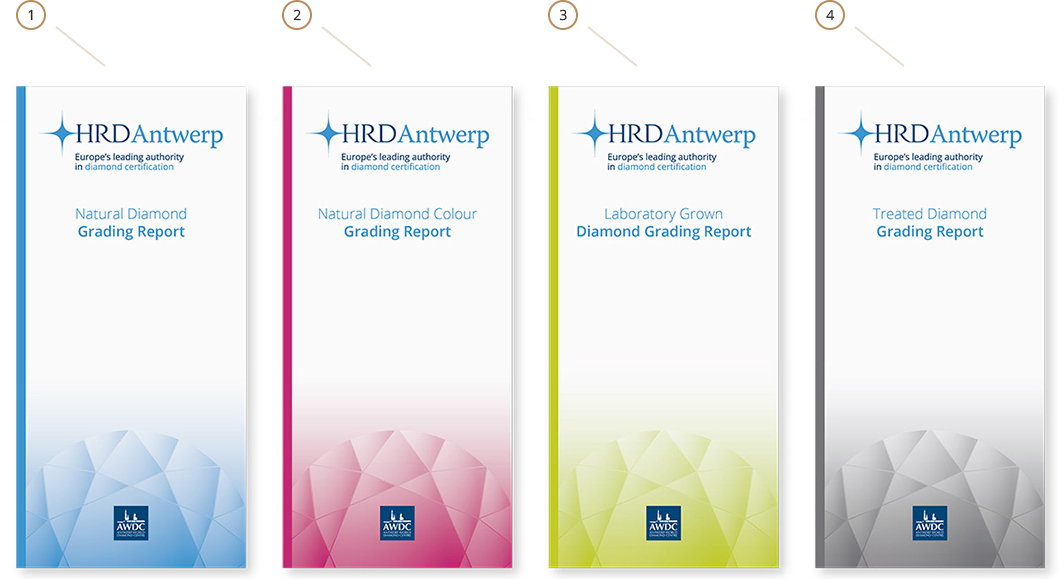
Appearance of HRD Antwerp diamond reports:
- for ordinary natural diamond diamonds from natural diamonds
- for colored diamonds from natural diamonds
- for diamonds from synthetic diamonds
- for natural refined diamonds
The type of gemological report on loose diamonds determines the nature of the origin of the diamond and the presence of refining by color or purity. In addition, in all types of reports information is indicated on the nature of the diamond from which the diamond is made, and on the type of refinement and its influence on the estimated factors - in the comments on the link. Also in all reports there is an individual number, information about the organization and the date of the report.
All reports for diamonds from natural diamonds of ordinary colors (Natural Diamond Report) contain information about the main evaluation parameters: the shape and type of cut, weight, color, purity, cut quality characteristics (proportions, polishing, symmetry), fluorescence intensity. Also in various forms, information is given on the linear dimensions of the stone and on the presence of laser engraving. In addition, reports on paper provide a block of information on the dimensional parameters of the cut (Technical Information), namely: the linear dimensions of the cut, the girdle's proportions and its features, the presence and size of the culet, the proportions of the overall height, the proportions of the platform, the proportions and angles of the main faces crowns and pavilions, proportions of the length of the paired wedges of the crown and pavilion, the sum of the angles of inclination of the main faces of the crown and pavilion. Information on the evaluation system and the position of the estimated parameters of the stone on the rating scales are given separately. As additional options may be included: laser engraving on the girdle surface, cutting classification according to the parameter “Hearts & Arrows” and individual packaging in a blister-container.
For ordinary color diamonds there are three report formats:
The report is issued for diamonds of less than 1.00 carats, the report format provides for the possibility of placing a plotting (identity diagram), but, as a rule, this option is not available. The organization’s website is confirmed both as an electronic text and as a document in PDF.
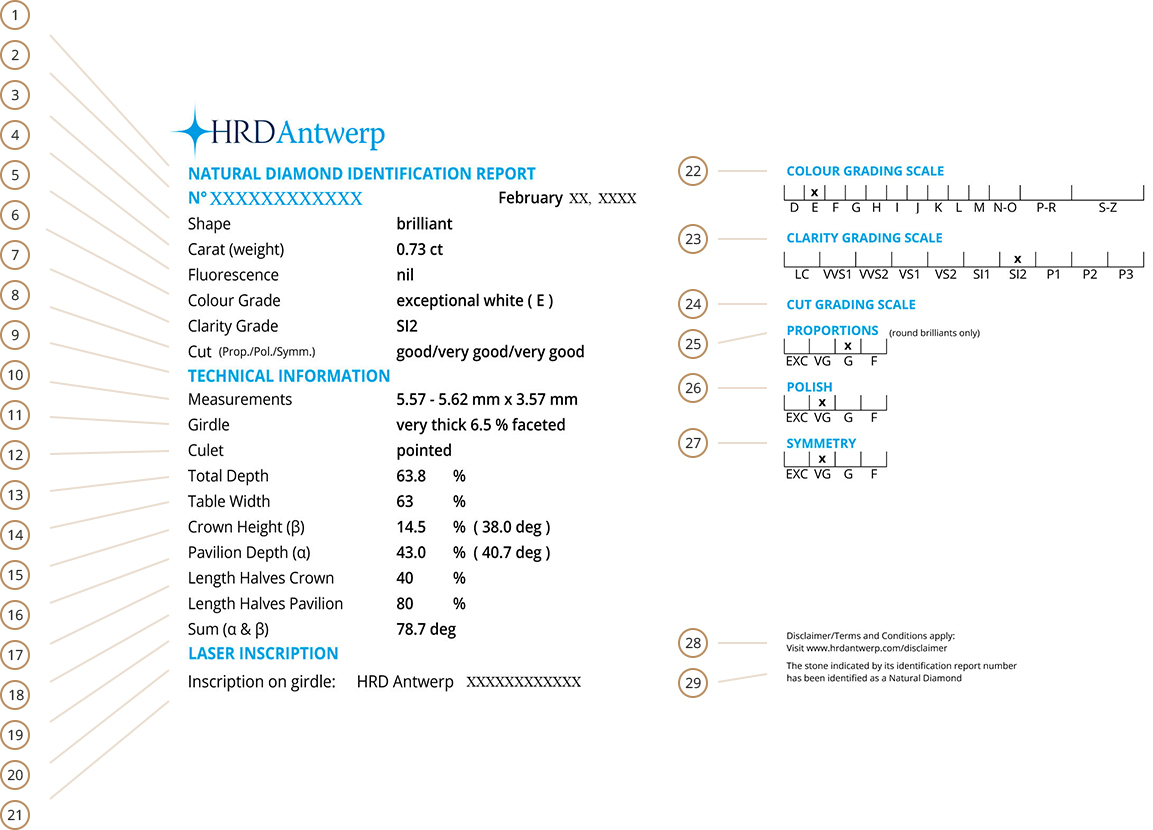
«Anatomy» of a gemological report «Natural Diamond Identification Report»:
- Report format
- Report number
- Date
- Shape
- Carat weight
- Fluorescence (intensity)
- Color characteristic
- Clarity characteristic
- Cut characteristic (proportions, polishing, symmetry)
- Technical information (11-20)
- Linear dimensions
- Girdle parameters
- Calette parameters
- Parameters of total height (%)
- Table parameters (%)
- Crown parameters (% and degrees)
- Pavilion parameters (% and degrees)
- Crown pair wedge length parameters (%)
- Parameters of the pavilion's pair wedges (%)
- The sum of the angles of inclination of the main face of the crown and the pavilion
- Laser inscription on the girdle of a diamond
- The position of the characteristics of the diamond on the color scale
- The position of the diamond characteristics on the scale of clarity
- The position of the characteristics of the diamond on the scales of evaluation of cutting parameters (25-26)
- Estimation of proportions (only for a round brilliant cut)
- Polishing grade
- Symmetry grading
- Reference to the source of information on terms and conditions of evaluation
- Stone Identification
The report is issued for diamonds of all sizes, the report always contains a plotting (identity chart). The organization’s website is confirmed both as an electronic text and as a document in PDF.
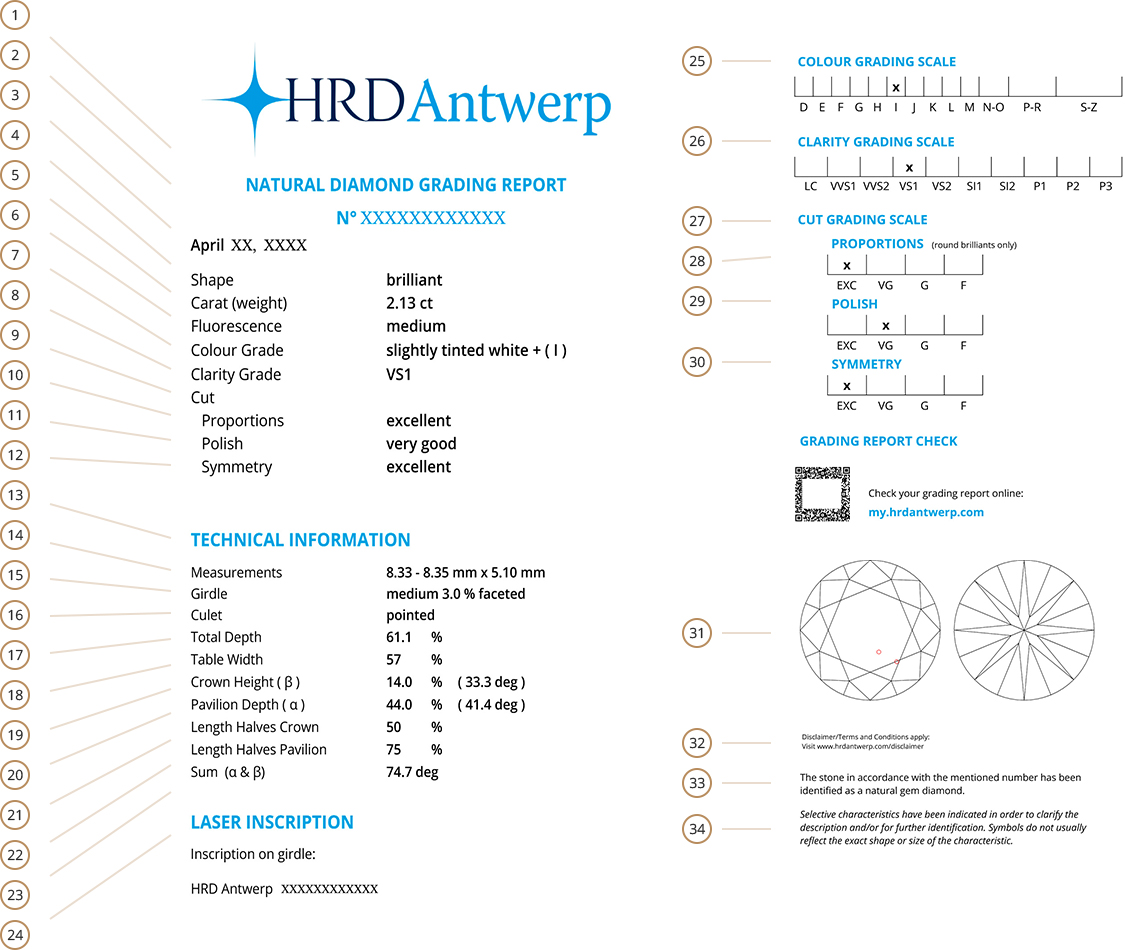
«Anatomy» of a gemological report «Natural Diamond Grading Report»:
- Report format
- Report number
- Date
- Shape
- Carat weight
- Fluorescence (intensity)
- Color characteristic
- Clarity characteristic
- Cut characteristic (10-12)
- Proportions characteristic
- Polishing characteristic
- Symmetry characteristic
- Technical information (14-23)
- Linear dimensions
- Girdle parameters
- Calette parameters
- Parameters of total height (%)
- Table parameters (%)
- Crown parameters (% and degrees)
- Pavilion parameters (% and degrees)
- Crown pair wedge length parameters (%)
- Parameters of the pavilion's pair wedges (%)
- The sum of the angles of inclination of the main face of the crown and the pavilion
- Laser inscription on the girdle of a diamond
- The position of the characteristics of the diamond on the color scale
- The position of the diamond characteristics on the scale of clarity
- The position of the characteristics of the diamond on the scales of evaluation of cutting parameters (28-30)
- Estimation of proportions (only for a round brilliant cut)
- Polishing grade
- Symmetry grading
- Identity chart (plotting)
- Reference to the source of information on terms and conditions of grading
- Stone identification
- Conditions and restrictions on the execution of an identity diagram (plotting)
The report is issued for diamonds sizes from 0.08 to 0.998 carats. Block «Technical Information» missing, but there is information about the linear dimensions of the stone. The block «Additional Information» provides for the possibility of placing the company logo. The card includes a container with a diamond, which has protection against opening. On the website of the organization information about the report is confirmed in the form of electronic text with a photo.
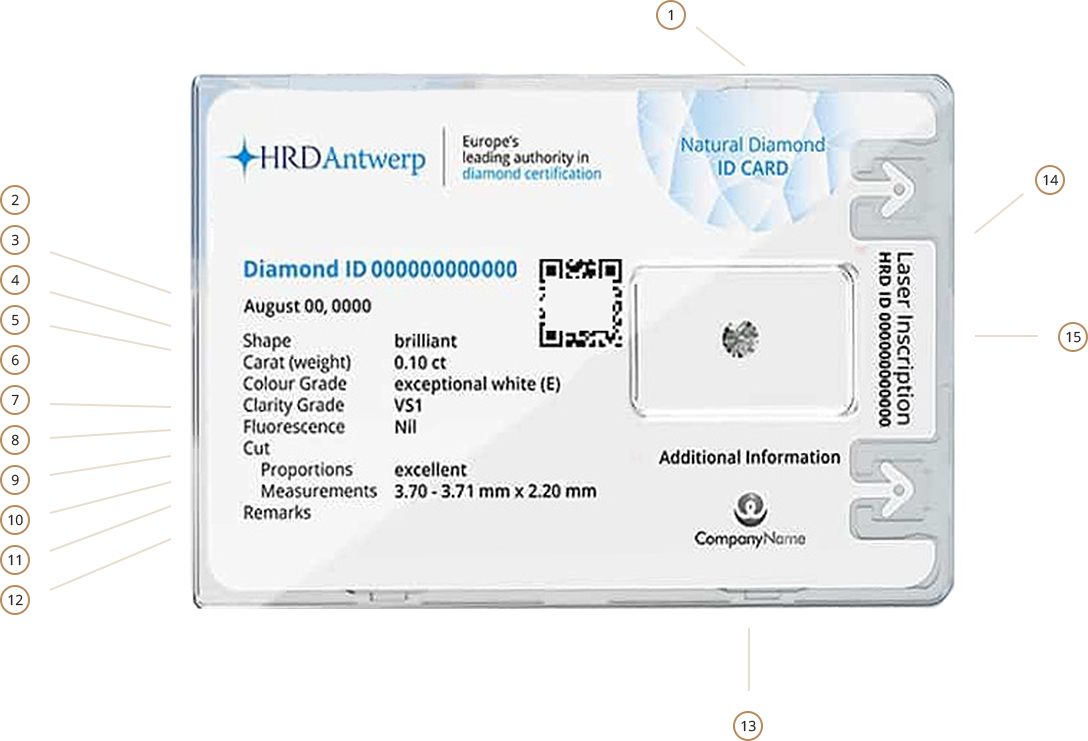
«Anatomy» of a gemological report «Natural Diamond ID CARD»
- Report format
- Report number
- Date
- Shape and type of cut
- Carat weight
- Color characteristic
- Clarity characteristic
- Fluorescence (intensity)
- Cut characteristic (10-11)
- Estimation of proportions (only for a round brilliant cut)
- Linear dimensions
- Notes
- Additional Information
- Laser inscription on the girdle of a diamond
- Diamond container
For natural colored diamond diamonds:
The report for a natural color diamond diamond (Natural Diamond Color Grading Report) contains information about the shape of the cut, weight, fluorescence intensity, diamond color, as well as the intensity and color of luminescence in the long wavelength (366 nm) and shortwave (254 nm) ultraviolet radiation and about the presence of laser engraving on the surface of the diamond girdle. In addition, the report provides information on the diamond's color grading system and on checking the origin of the color. As additional options may be included: laser engraving on the girdle surface and packing in a blister-container. The organization’s website is confirmed both as an electronic text and as a document in PDF.
For synthetic diamonds:
The report for a diamond made of synthetic diamonds (Laboratory Grown Diamond Grading Report) contains information on the main evaluation parameters: the shape and type of cut, weight, color, purity, cut quality characteristics (proportions, polishing, symmetry), fluorescence intensity. Information is also provided on the presence of laser engraving and a block of information on the dimensional parameters of the cut (Technical Information), namely: the linear dimensions of the cut, the proportions of the girdle and its features, the culet, the proportions of the total height, the proportions of the platform, the proportions and angles of the main faces of the crown and pavilion , the proportions of the length of the paired wedges of the crown and the pavilion, the sum of the angles of inclination of the main faces of the crown and the pavilion. Separately, information is given on the evaluation system and the position of the estimated stone parameters on the rating scales, as well as a diagram of the diamond identity (plotting). Laser engraving on the surface of a diamond girdle is included in the mandatory option. As additional options may be included: cut classification by parameter «Hearts and Arrows» and packing in a blister. The organization’s website is confirmed both as an electronic text and as a PDF document..
For natural cut diamonds that have been refined:
The report for a diamond from natural diamonds subjected to refinement (Treated Diamond Grading Report) contains information on the main evaluation parameters: the shape and type of faceting, weight, color, clarity, quality characteristics of the faceting (proportion, polishing, symmetry), fluorescence intensity. In addition, information is provided on the presence of laser engraving and a block of information on the dimensional parameters of the cut (Technical Information), namely: the linear dimensions of the cut, the proportions of the girdle and its features, the culet, the proportions of the total height, the proportions of the platform, the proportions and angles of the pavilion, the proportions of the length of the paired wedges of the crown and the pavilion, the sum of the angles of inclination of the main faces of the crown and the pavilion. Separately, information is given on the evaluation system and the position of the estimated stone parameters on the rating scales, as well as a diagram of the diamond identity (plotting). Information about the impact of refining on the estimated parameters is given in the comments on the link, and also indicates the presence of refining signs in a separate text block. If HPHT detection is detected, laser engraving is applied to the girdle of a diamond. As an additional option, packaging in a blister-container can be made. The organization’s website is confirmed both as an electronic text and as a document in PDF.
Gemological report for diamonds set in jewelry:
Gemological report for diamonds set in jewelery (Jewellery Report) contain:
- block of information about the product, which indicates: the type of jewelry, an indication of the sample stamp, information about the metal and its sample, the total weight of the product, the number of diamonds, the estimated weight of diamonds, as well as a photo of the jewelry;
- a block of information about diamonds by groups of homogeneous inserts, which indicate: the number of diamonds, the shape and type of cut, the total calculated weight, the color score (depending on the type of bartack with a particular tolerance), the purity rating, the symmetry rating, an indication of the mount type;
- comments, which indicate the presence of jewelry stones and inserts other than diamonds, the presence of laser engravings on diamonds, as well as other important factors for the description of the product;
- information on nature identification and diamond refinement is separately indicated;
- reports may contain a block of additional information, which provides information on the presence of engravings and inscriptions on jewelry and stones, manufacturer, design and collection accessories.
For jewelry with diamonds there are 3 formats of gemological reports:
Compact document issued in the form of a plastic card. On the website of the organization is confirmed only in the form of electronic text with a photo.
A document issued as a paper document. The organization’s website is confirmed both as an electronic text and as a document in PDF.
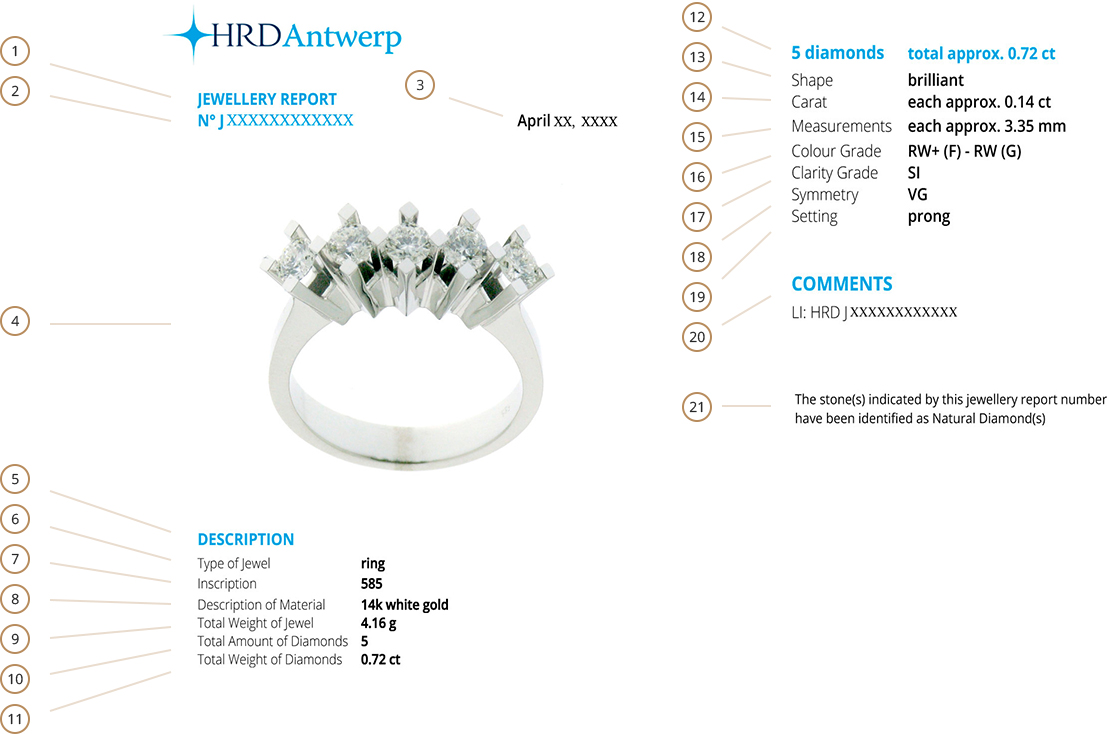
«Anatomy» of a gemological report «Jewellery Report (compact
- Report format
- Report number
- Date
- Photo
- Jewellery information block (6-11)
- Type of jewellery
- Hallmarks
- Metal and its test
- Total weight
- Total number of diamond inserts
- Total estimated diamond weight in carats
- The number and estimated weight of carat diamonds group
- Shape and type of cut
- Estimated average weight of each stone in the group
- The average size of the stone in the group
- Color characteristic
- Clarity characteristic
- Symmetry characteristic of cut
- Kind of tack
- Comments (information on laser inscription on a diamond)
- Information on the diagnosis of the nature of the origin of diamonds
A document issued as a paper document. It also contains information on the diamond pricing system and a description of the main types of diamond attachment in jewelry. The organization’s website is confirmed both as an electronic text and as a document in PDF.

«Anatomy» of a gemological report «Jewellery Report (compact)»:
- Report format
- Report number
- Date
- Photo
- Jewellery information block (6-11)
- Type of jewellery
- Hallmarks
- Metal and its test
- Total weight
- Total number of diamond inserts
- Total estimated diamond weight in carats
- The number and estimated weight of carat diamonds group
- Shape and type of cut
- Estimated average weight of each stone in the group
- The average size of the stone in the group
- Color characteristic
- Clarity characteristic
- Symmetry characteristic of cut
- Kind of tack
- Description of another group of homogeneous diamond inserts
- Comments (information on other inserts of jewellery stones)
- nformation on the rating system (color, clarity) and the definition of the main types of diamond setting in the product
- Information on the diagnosis of the nature of the origin of diamonds
- Additional terms information

